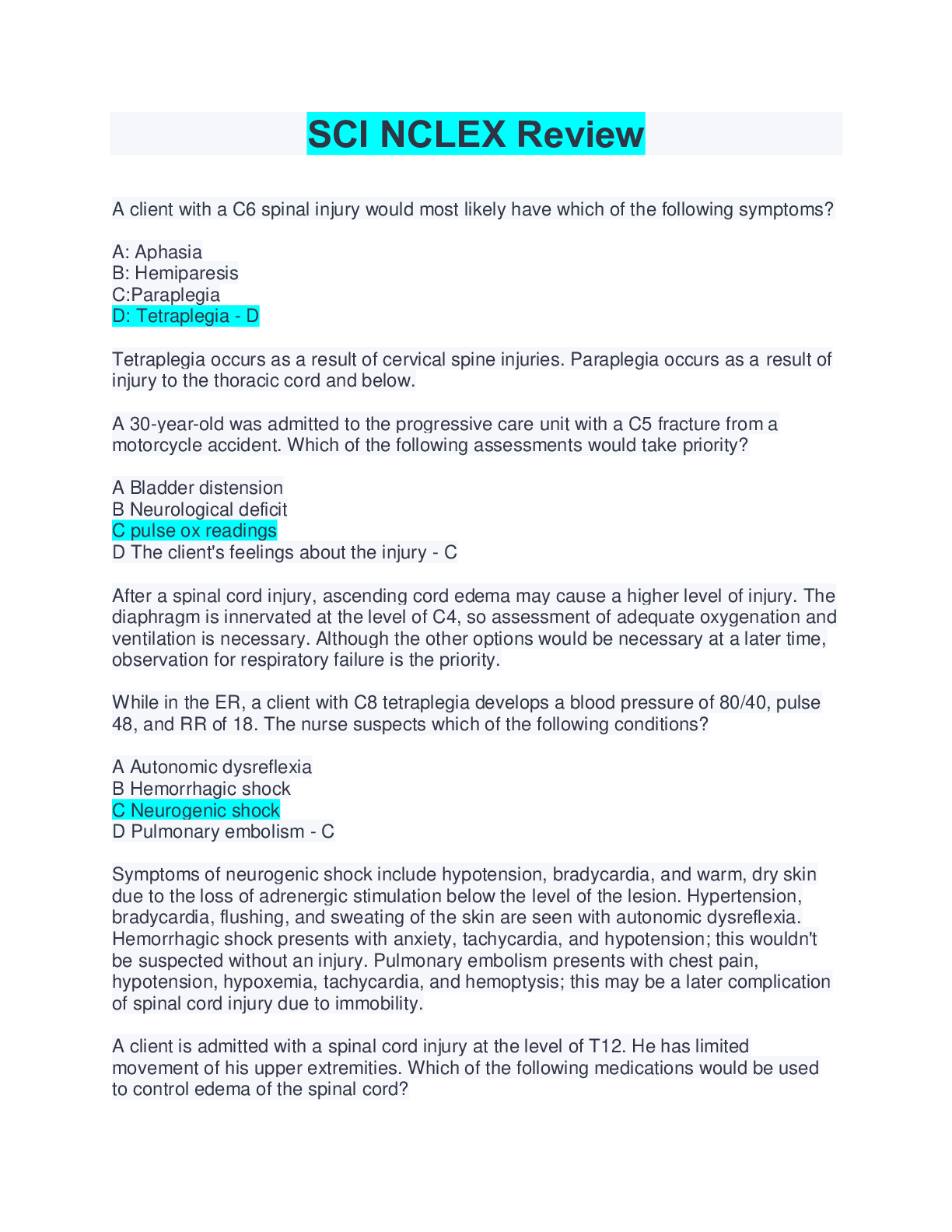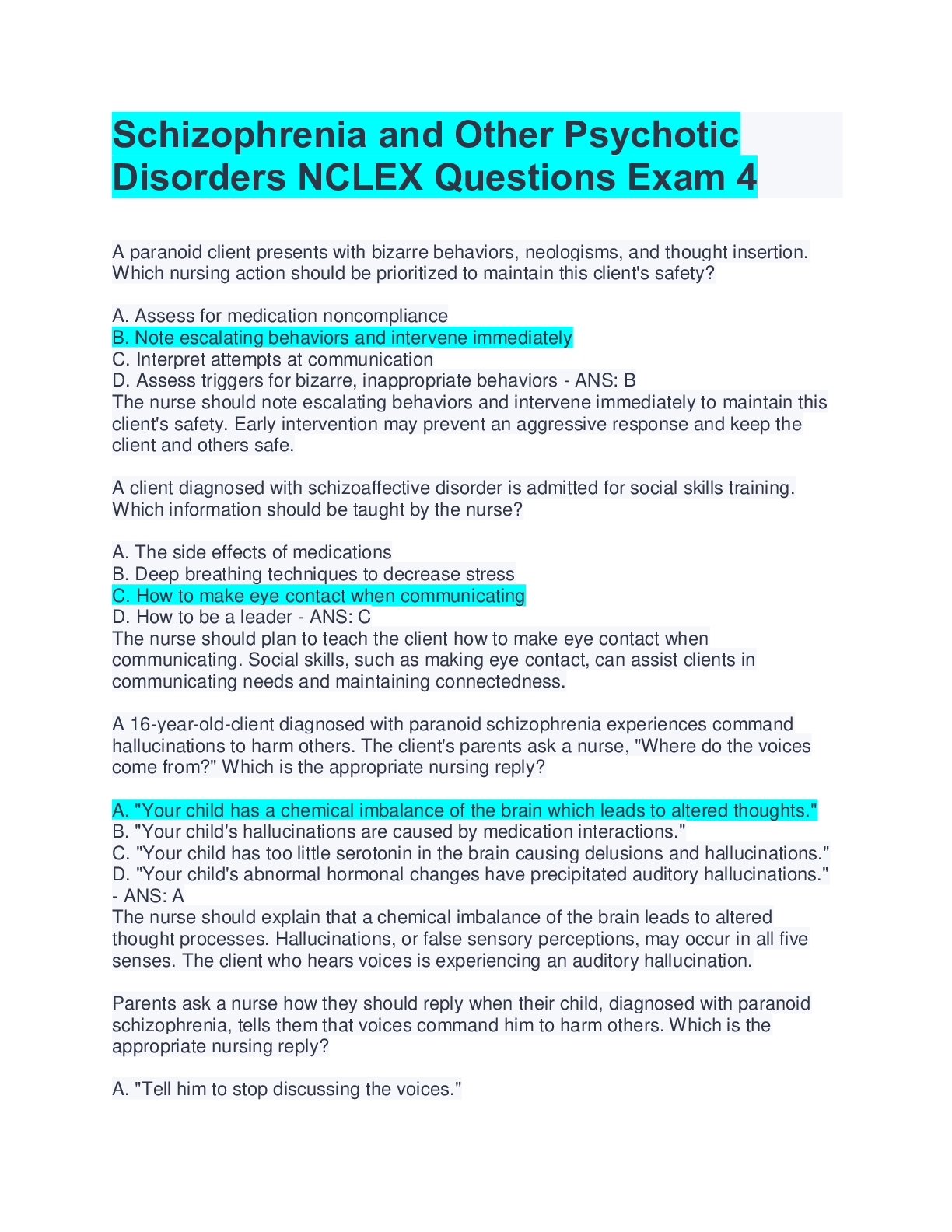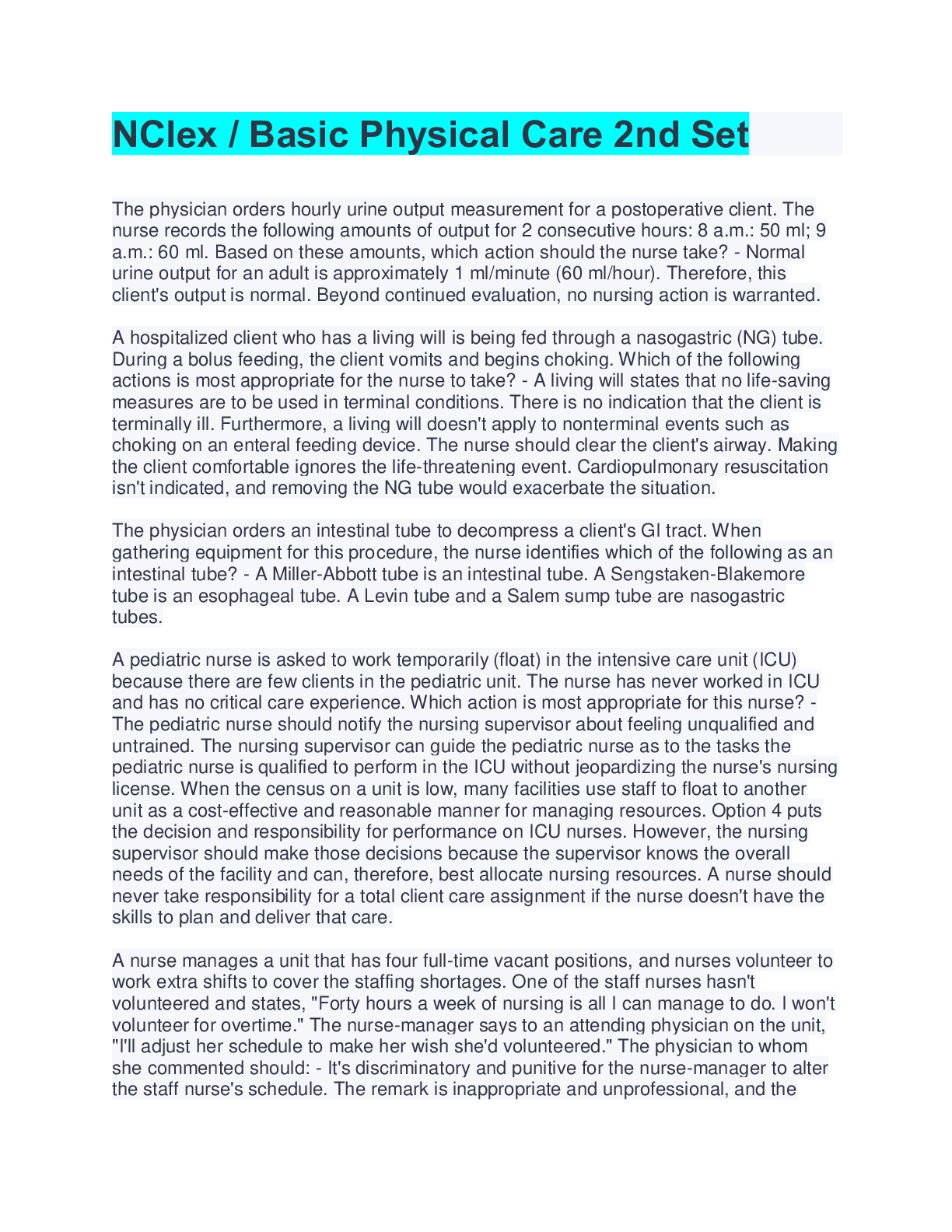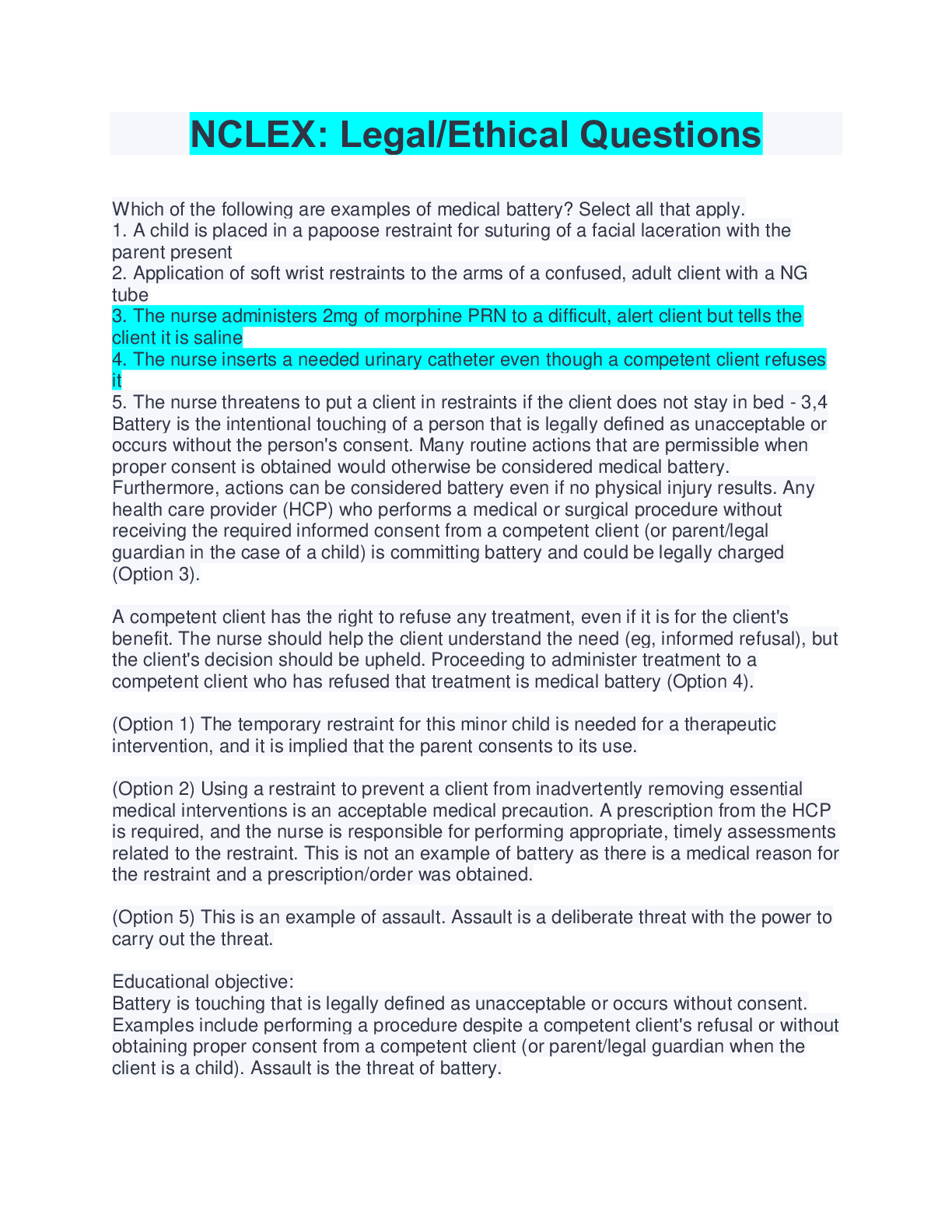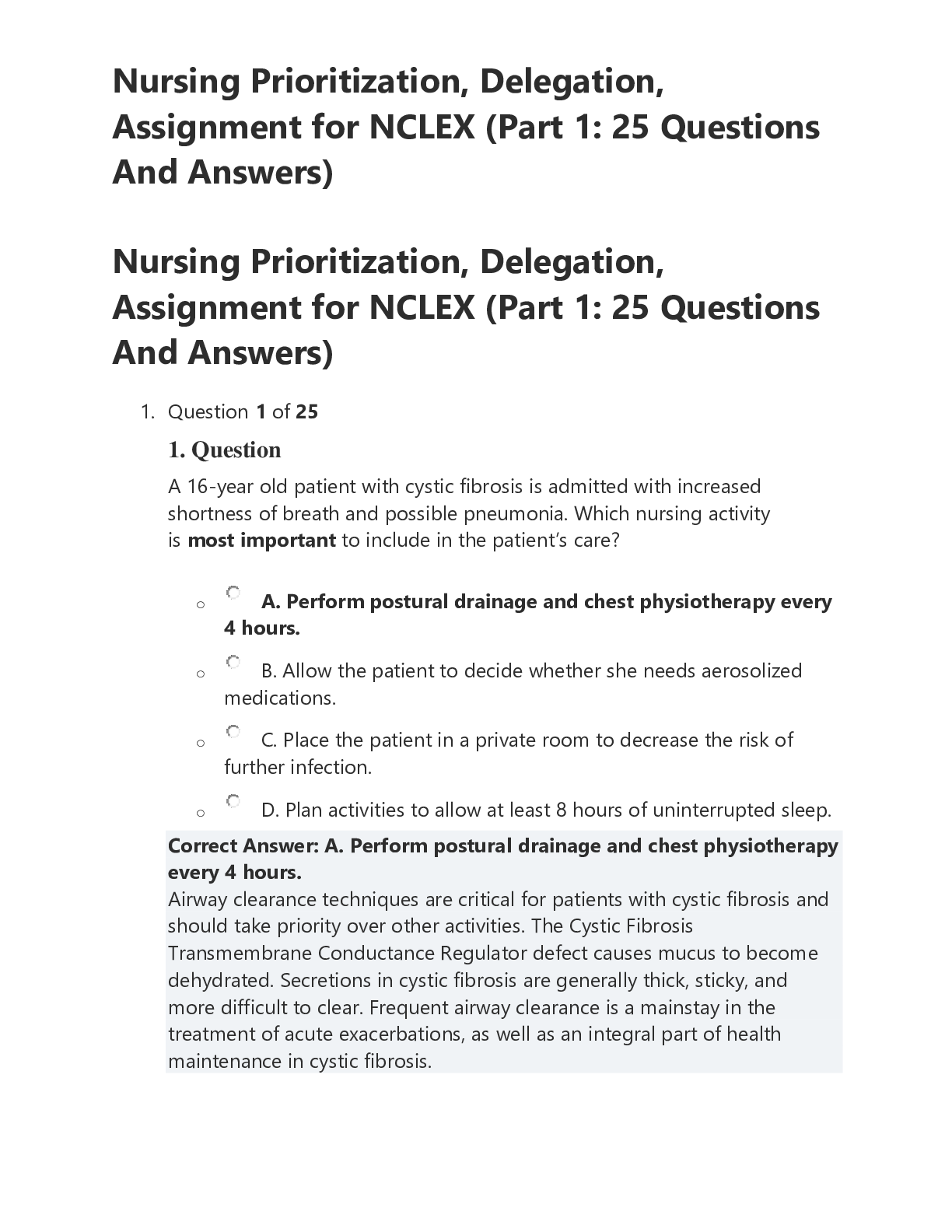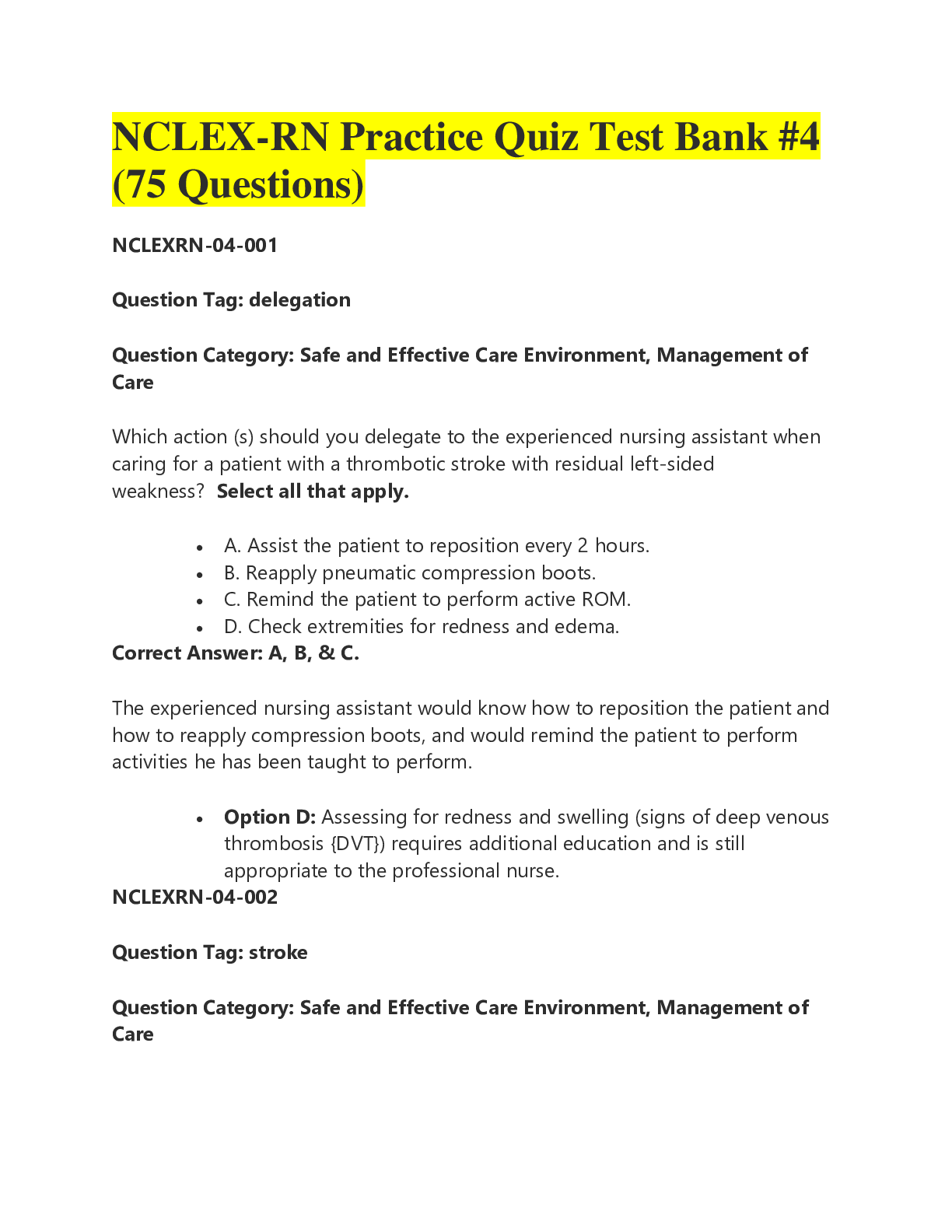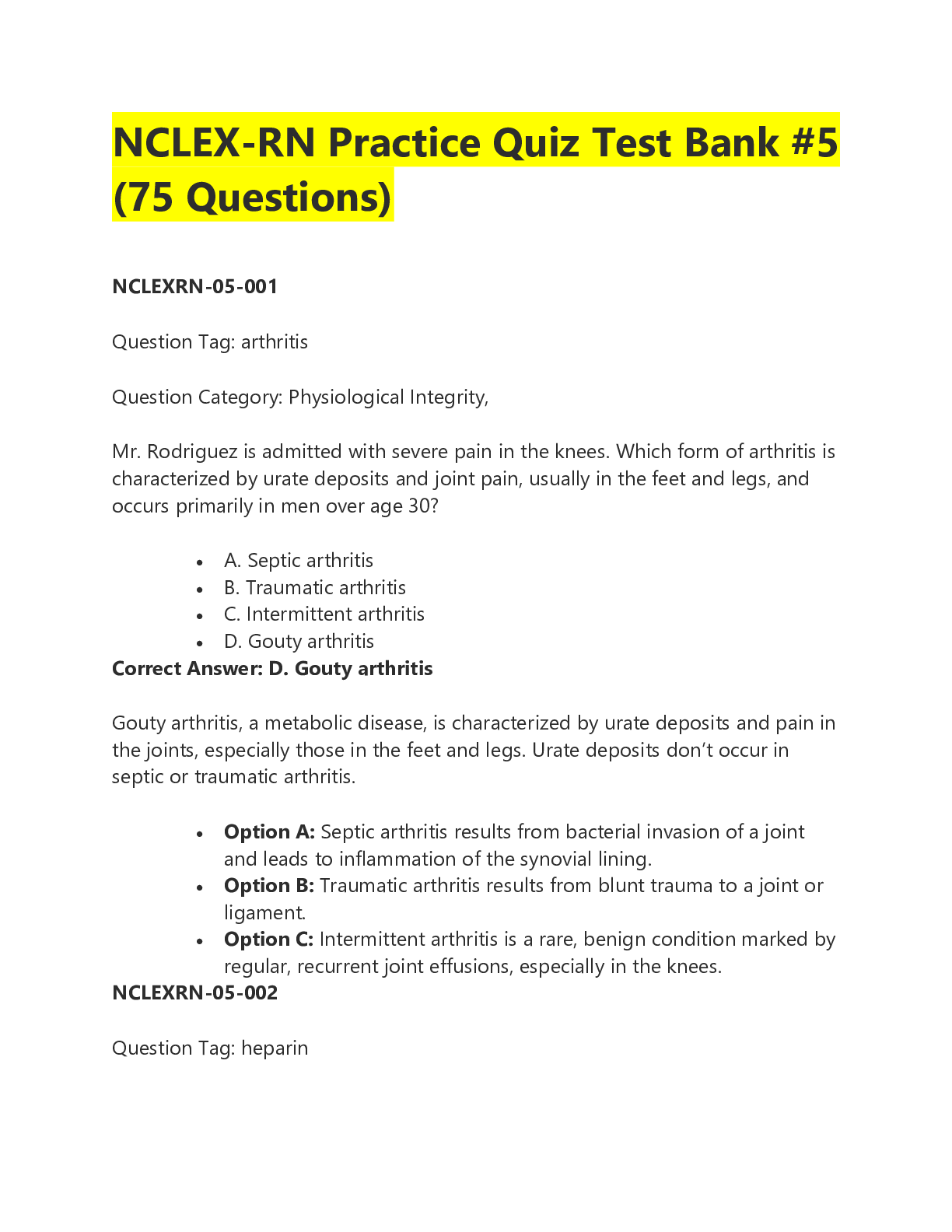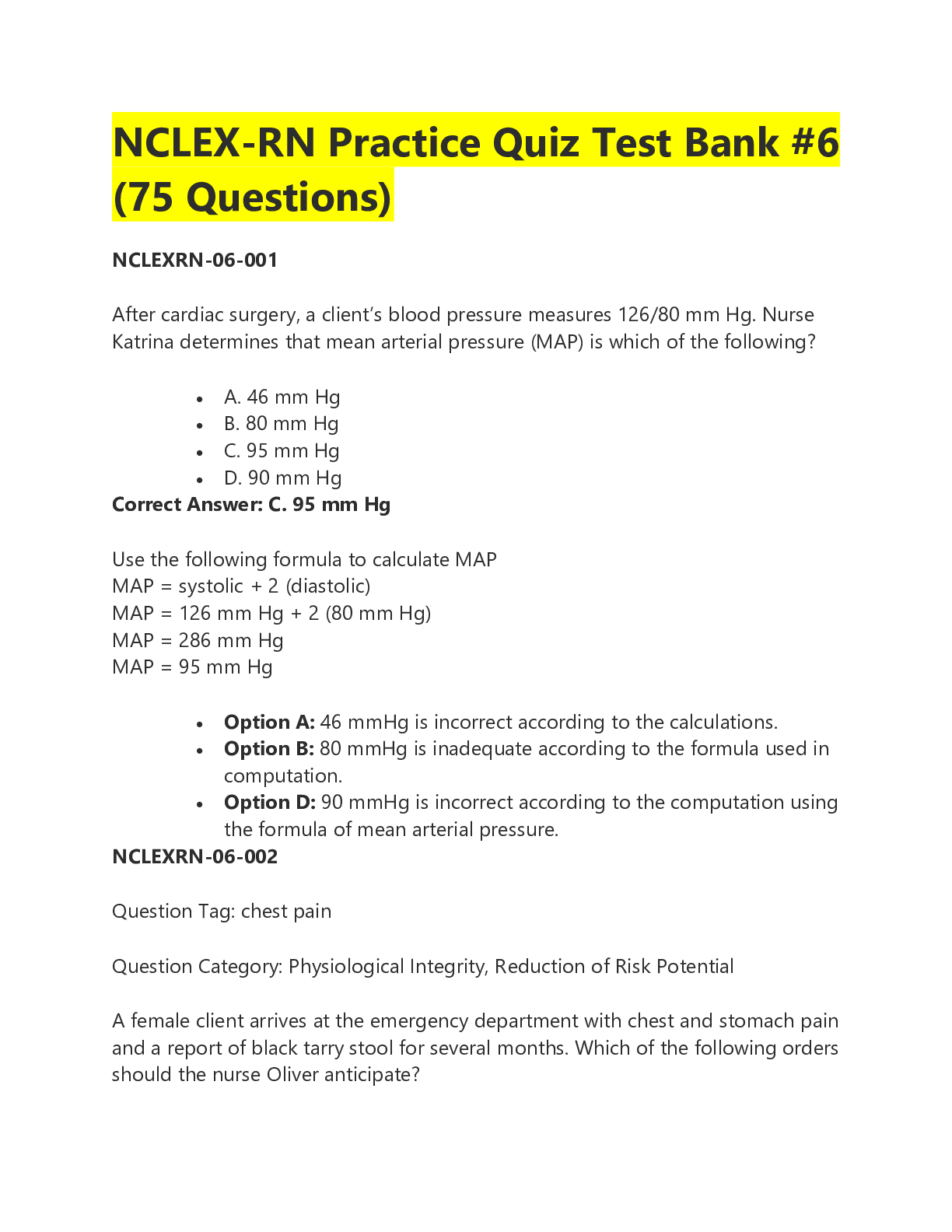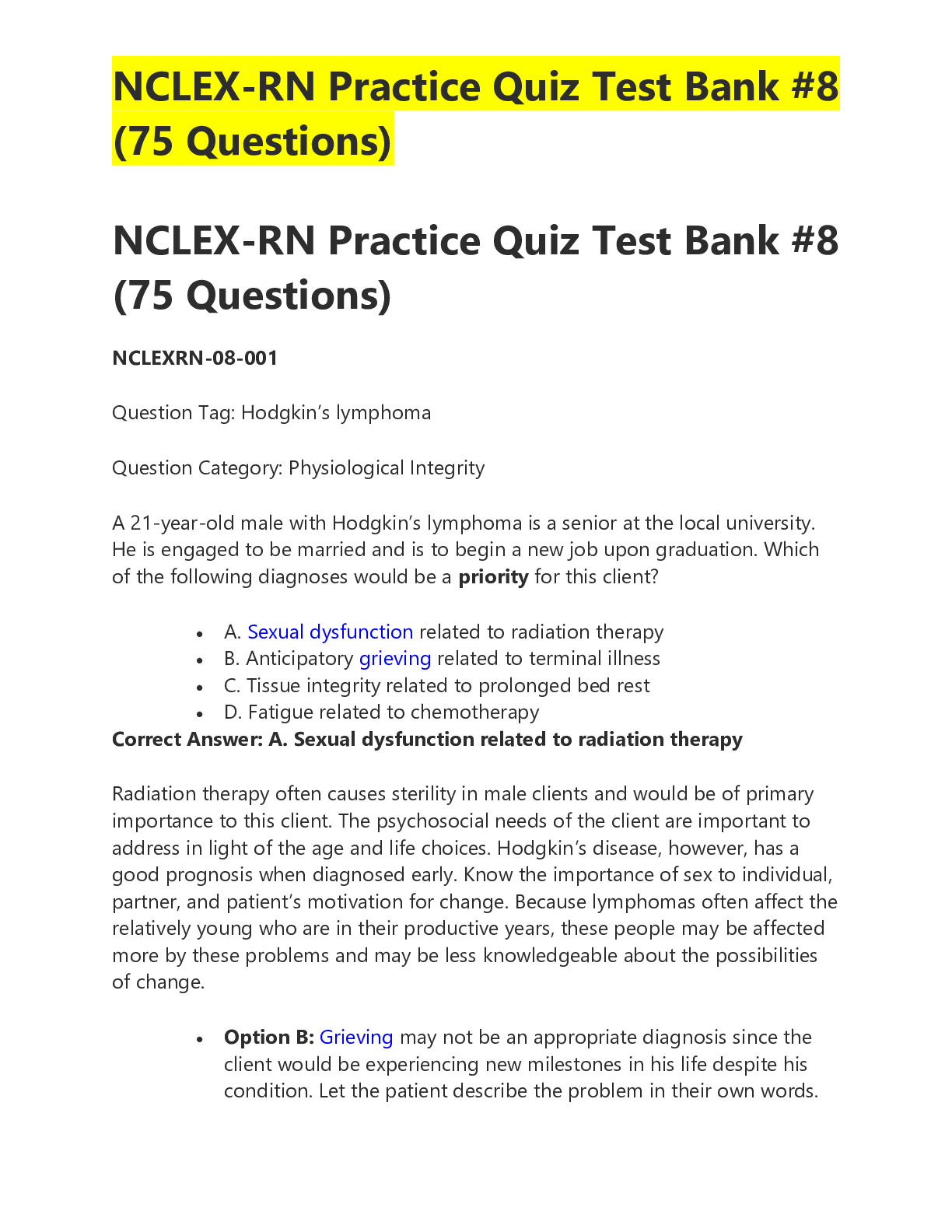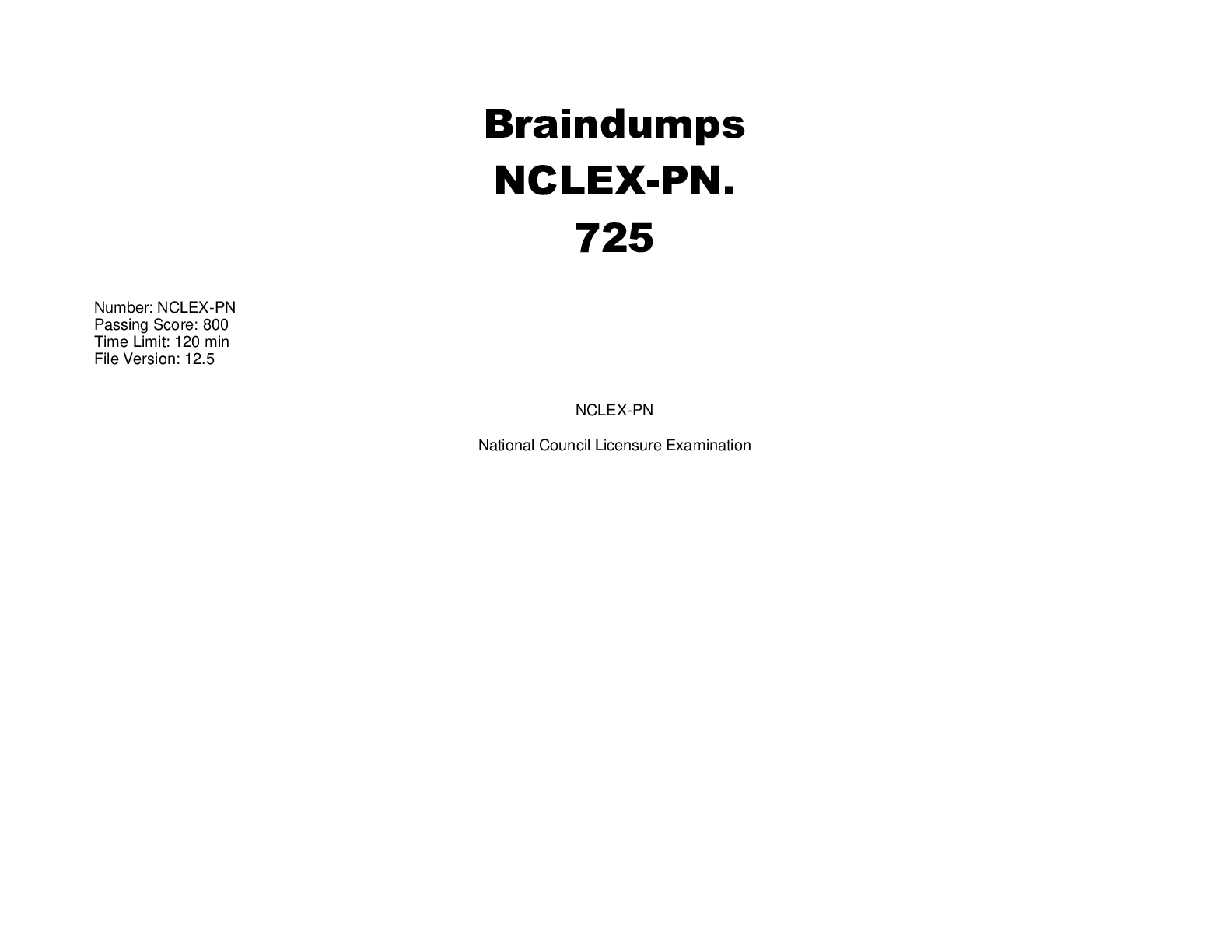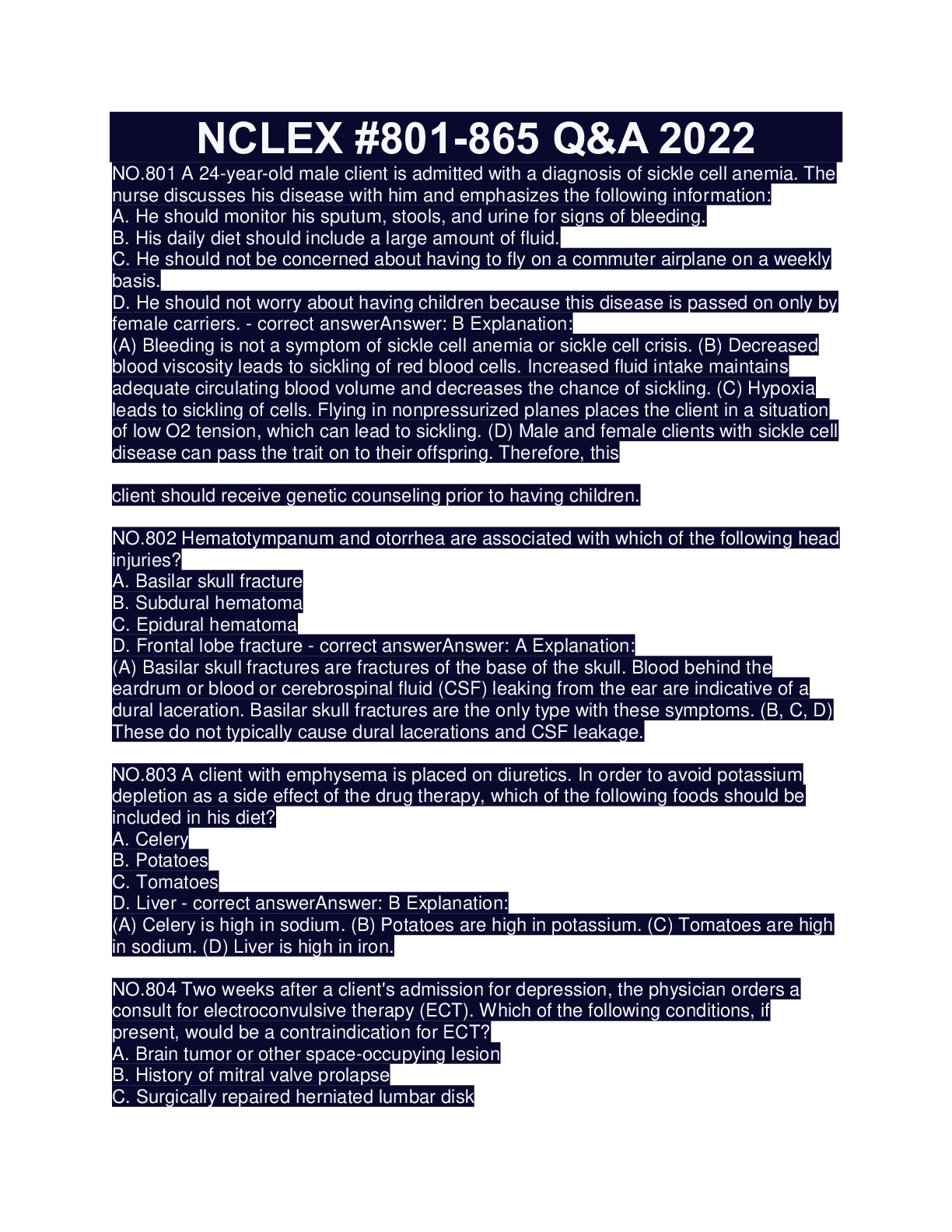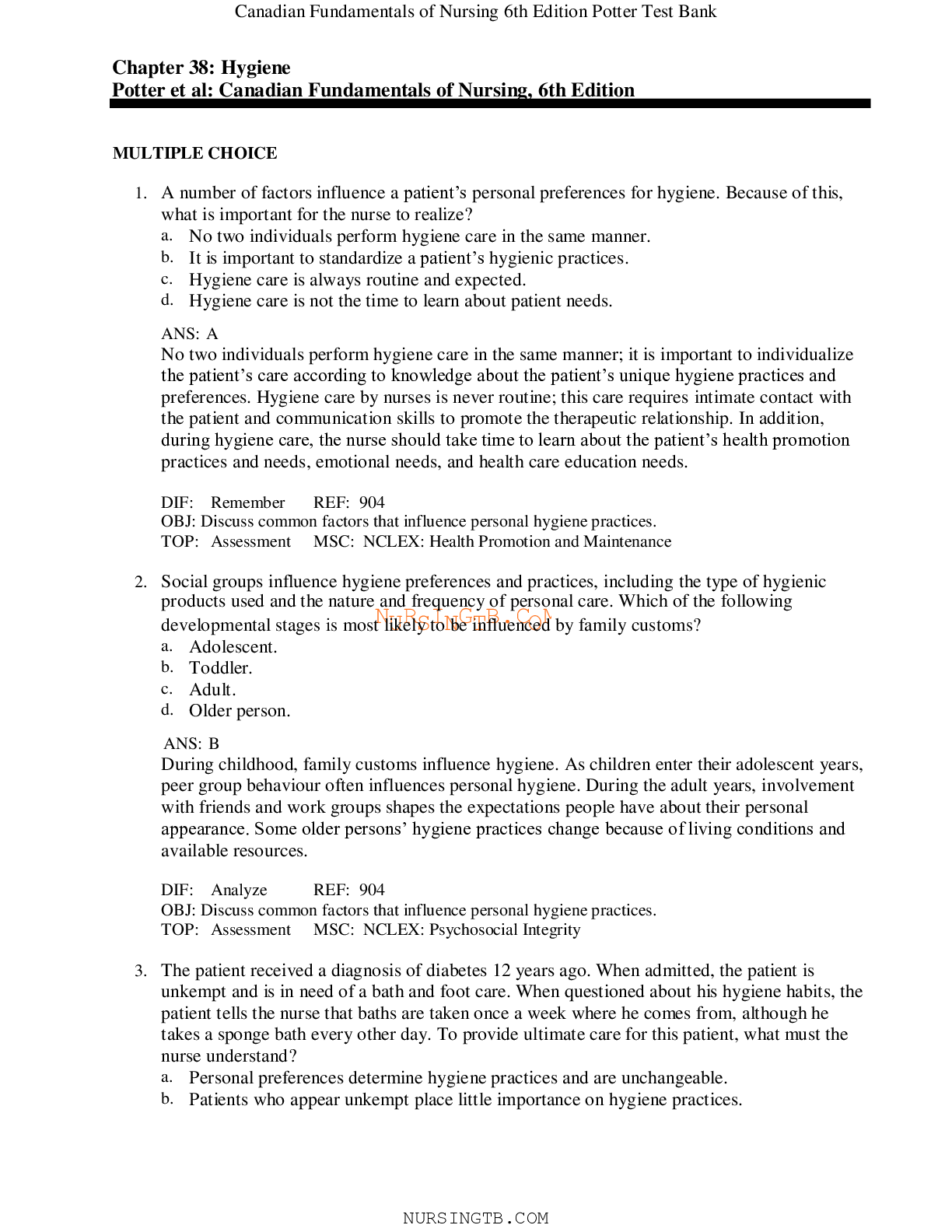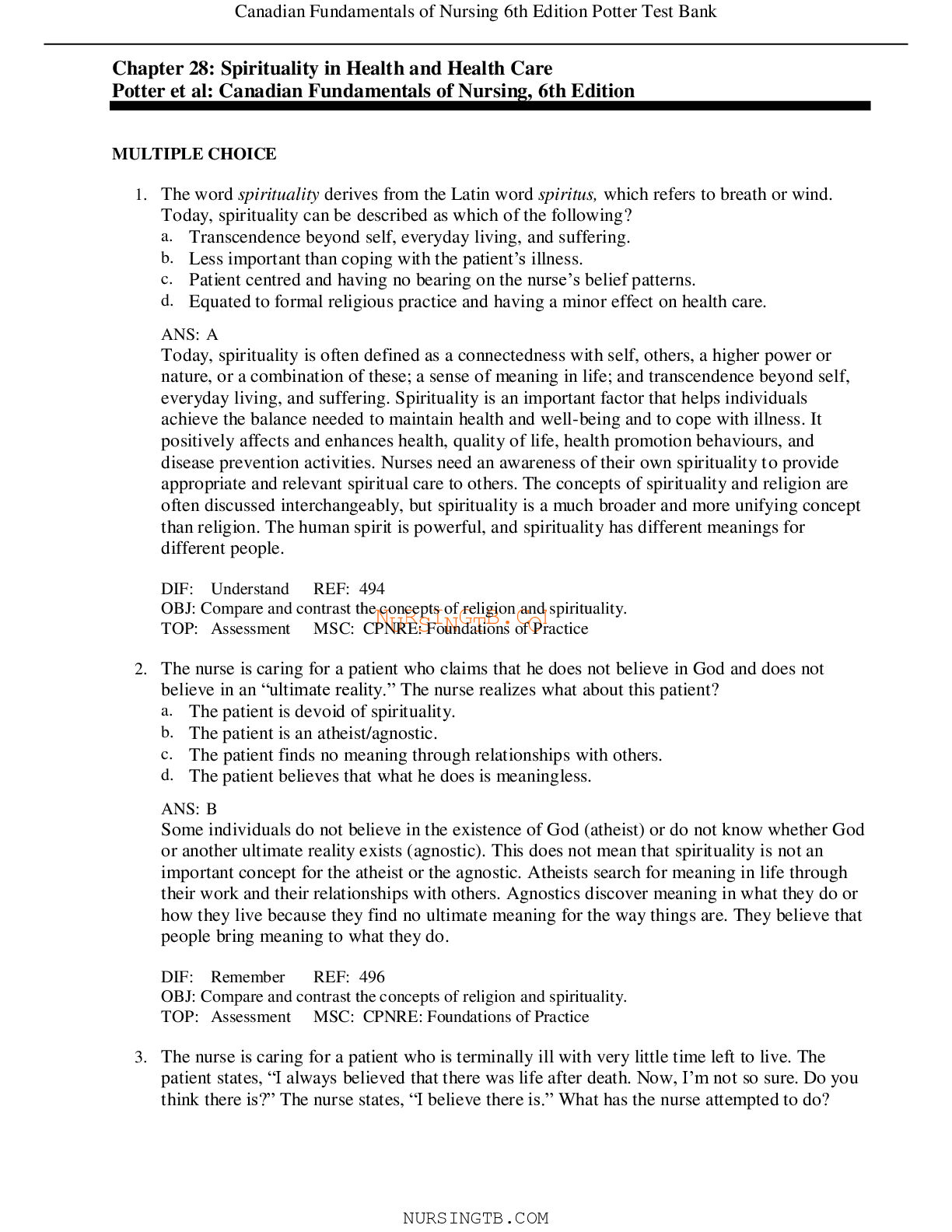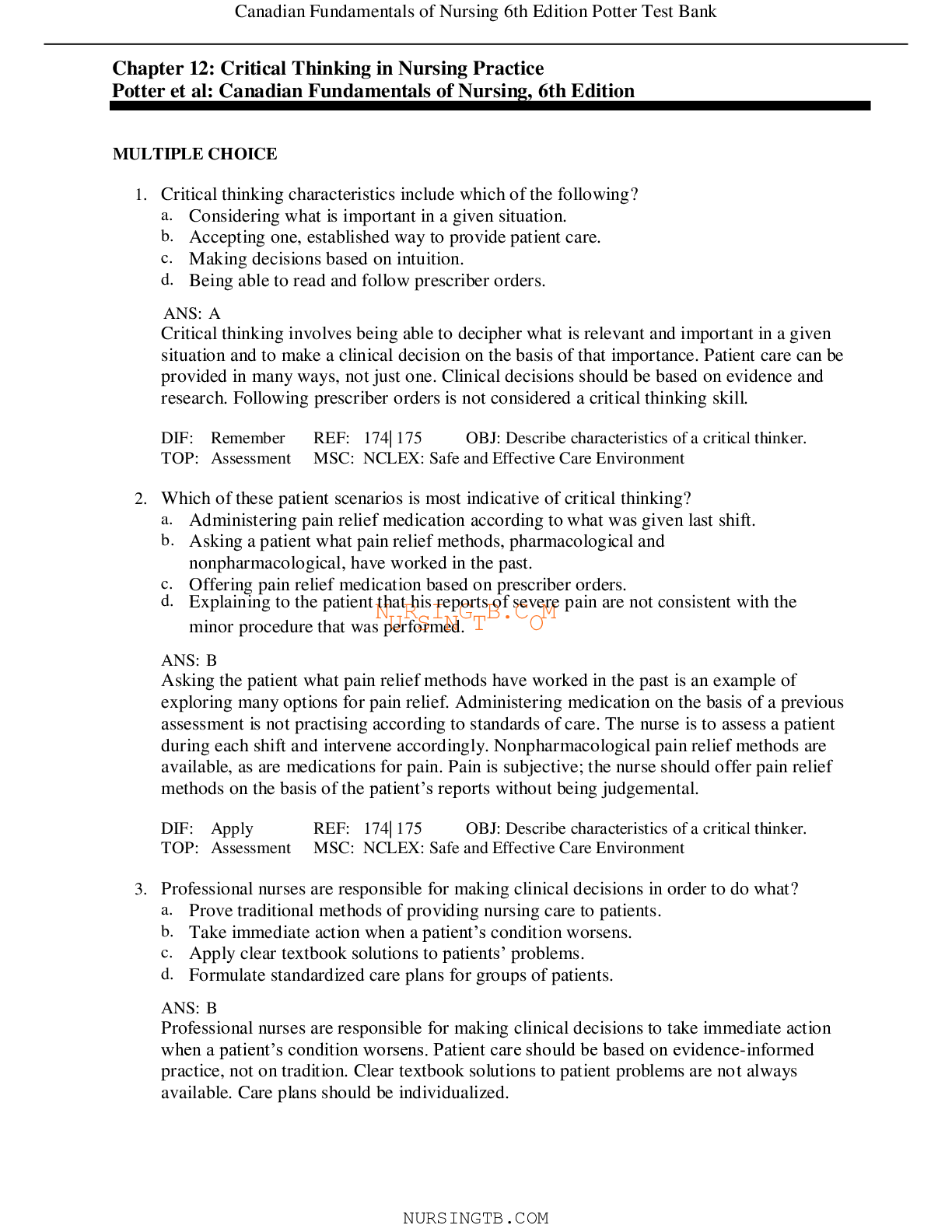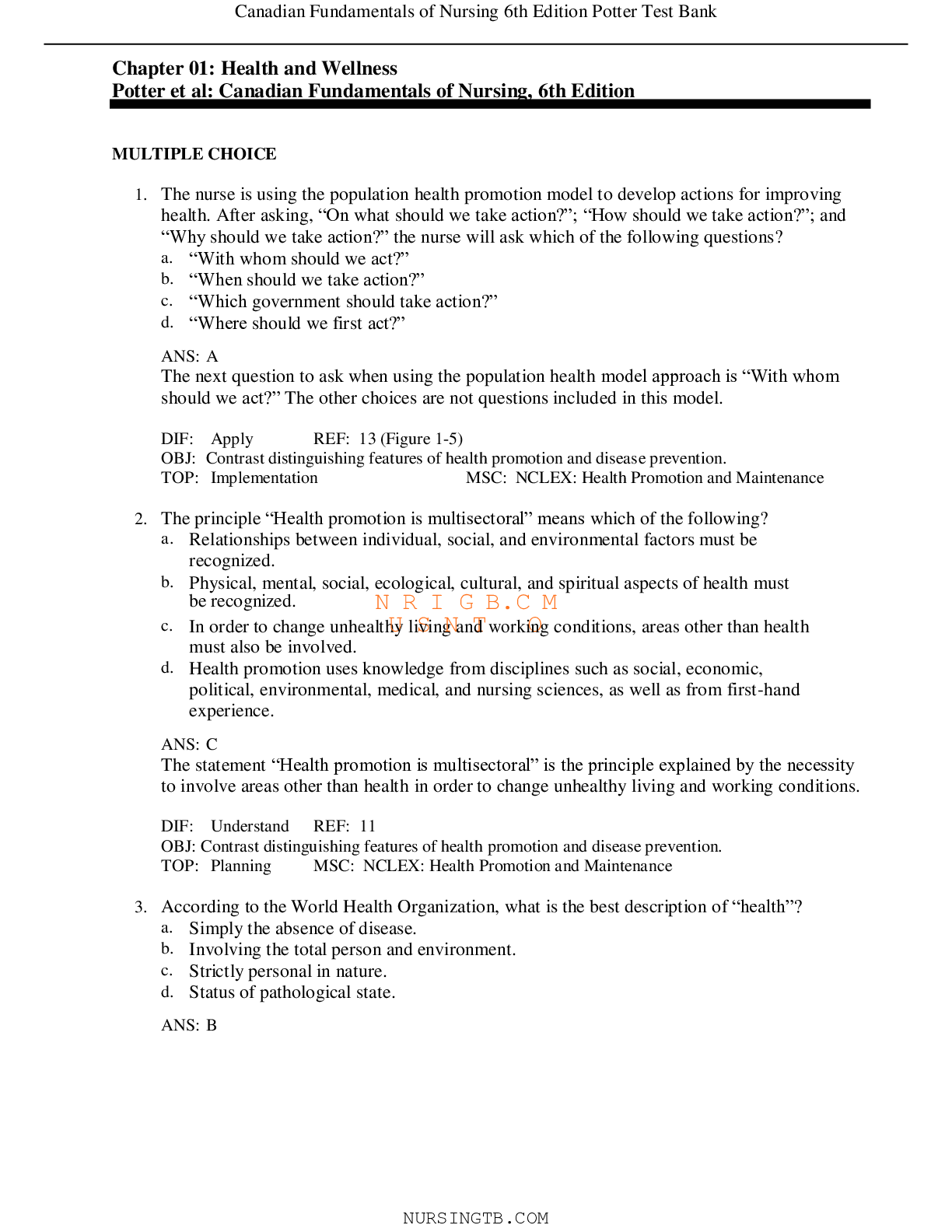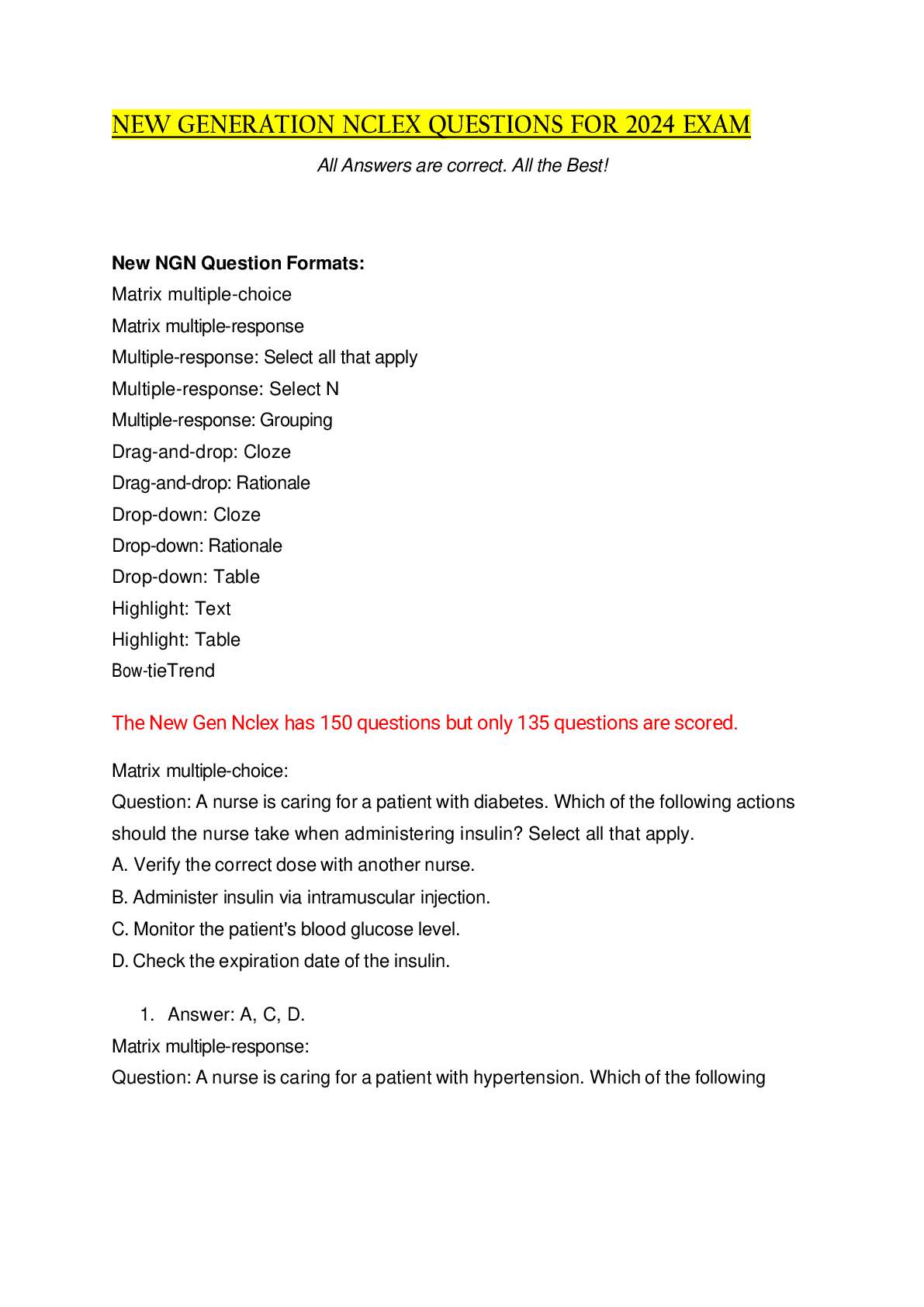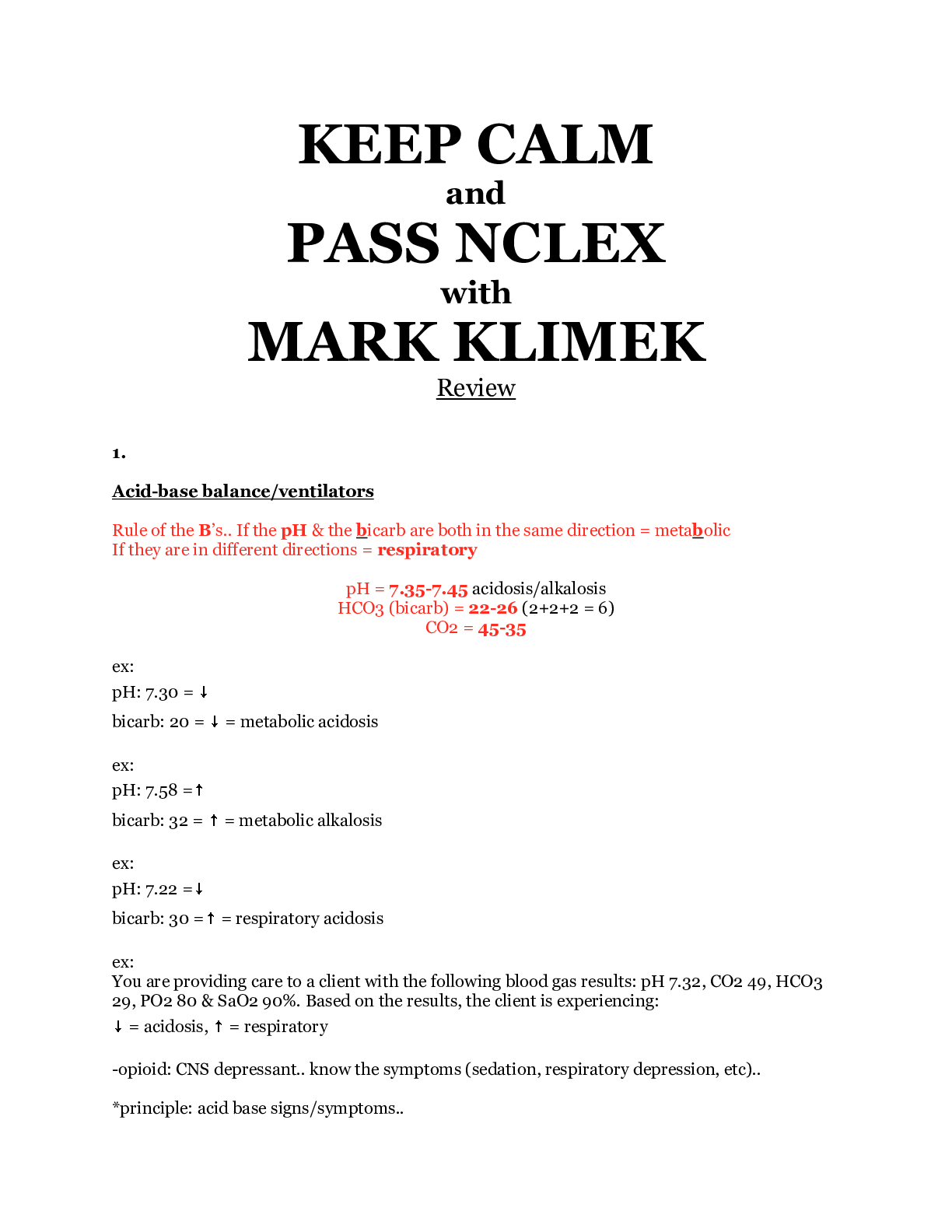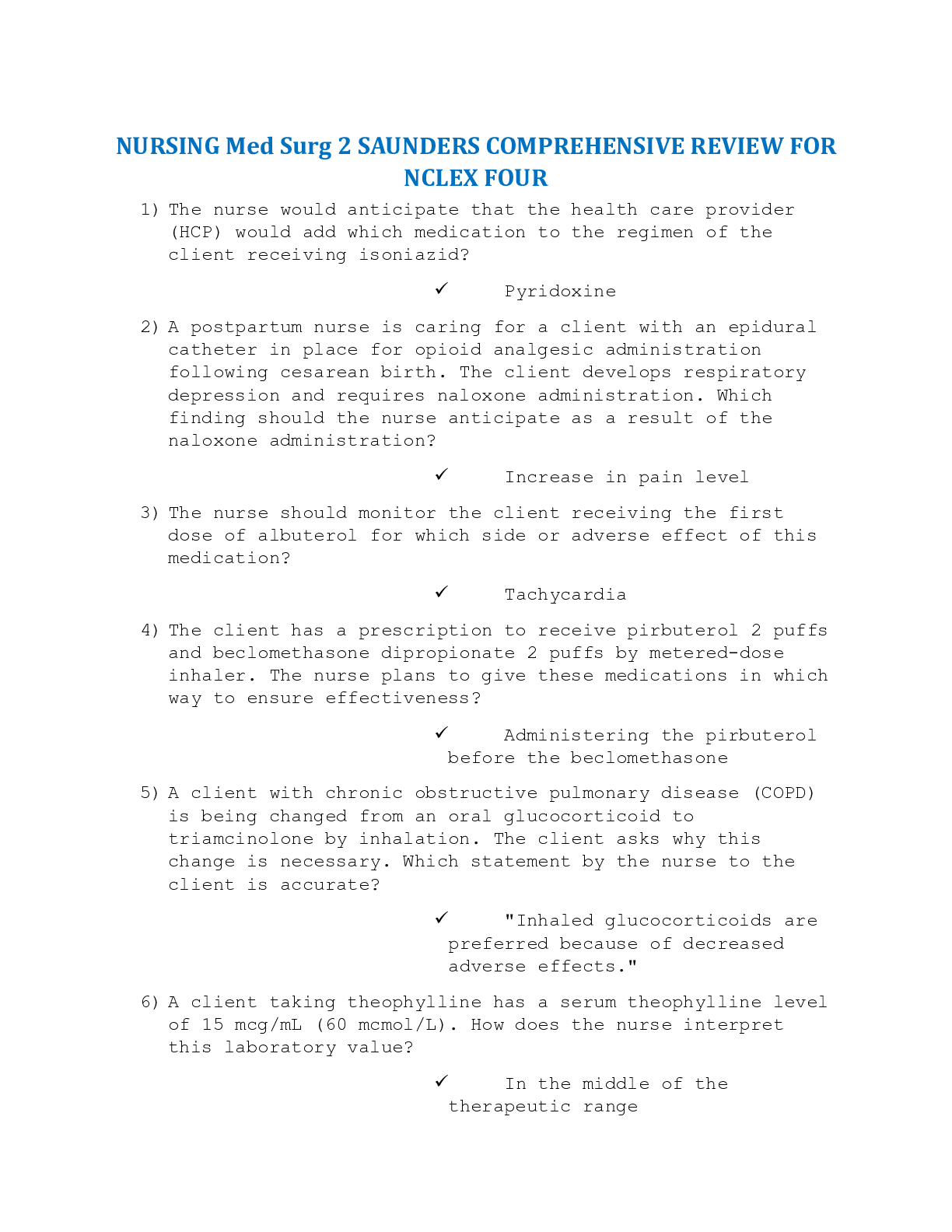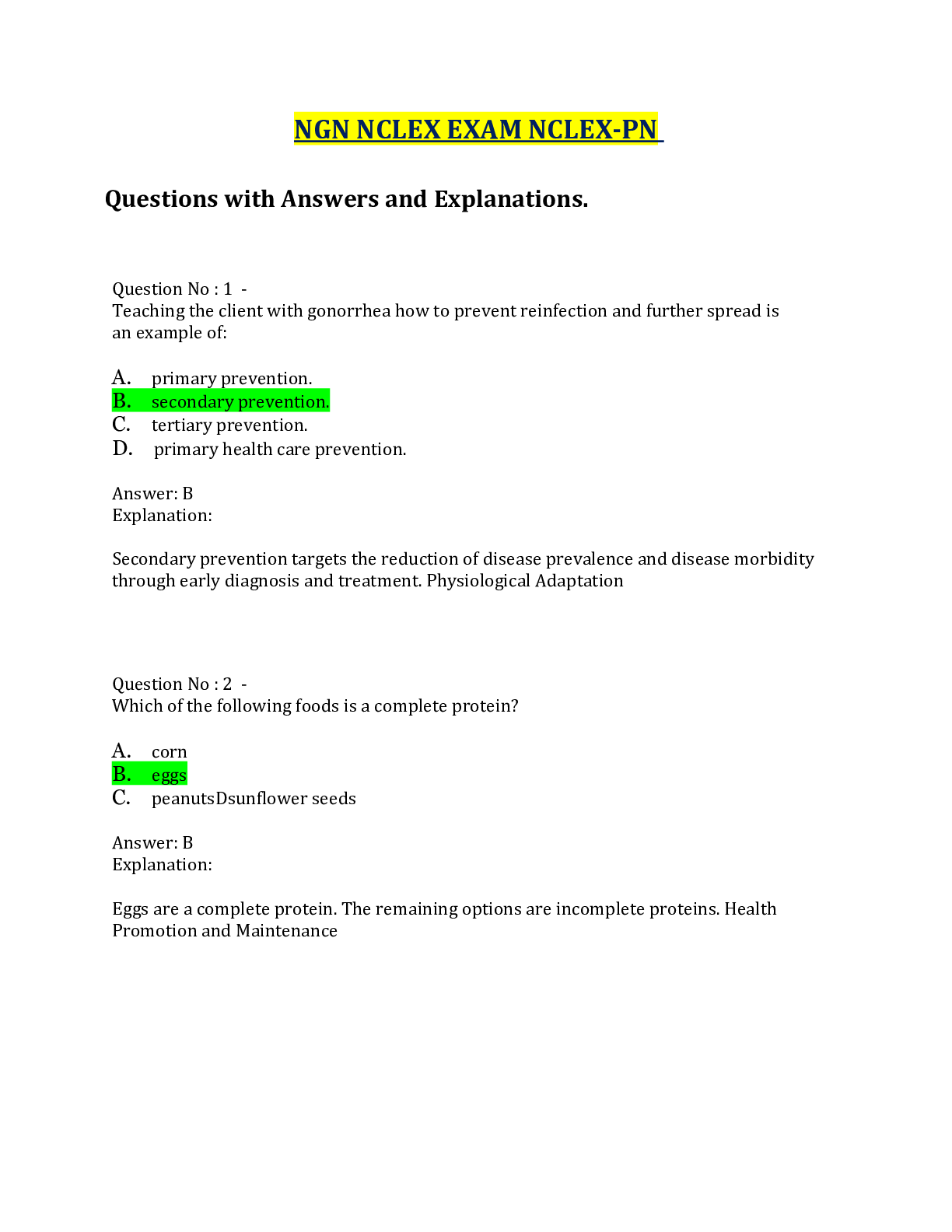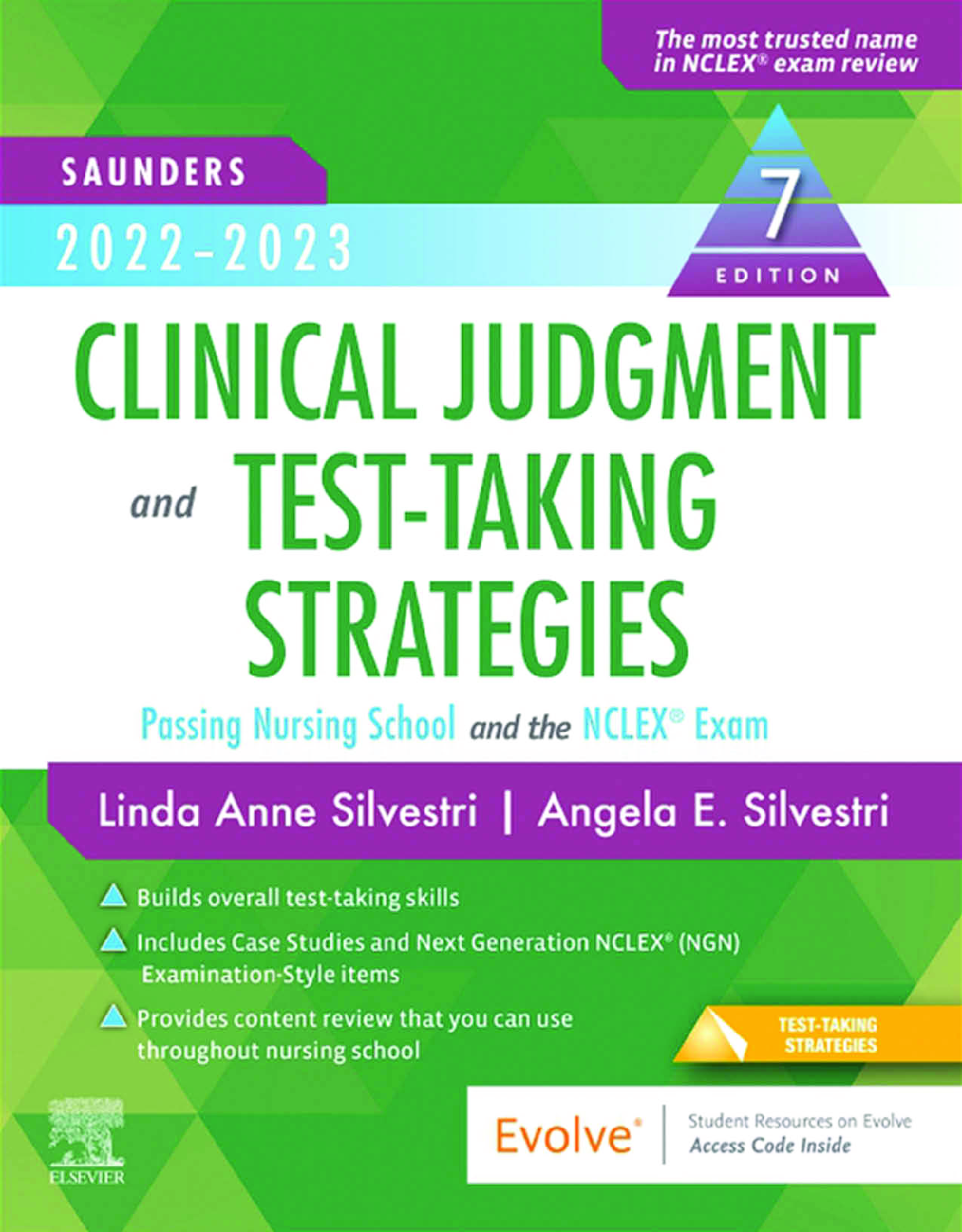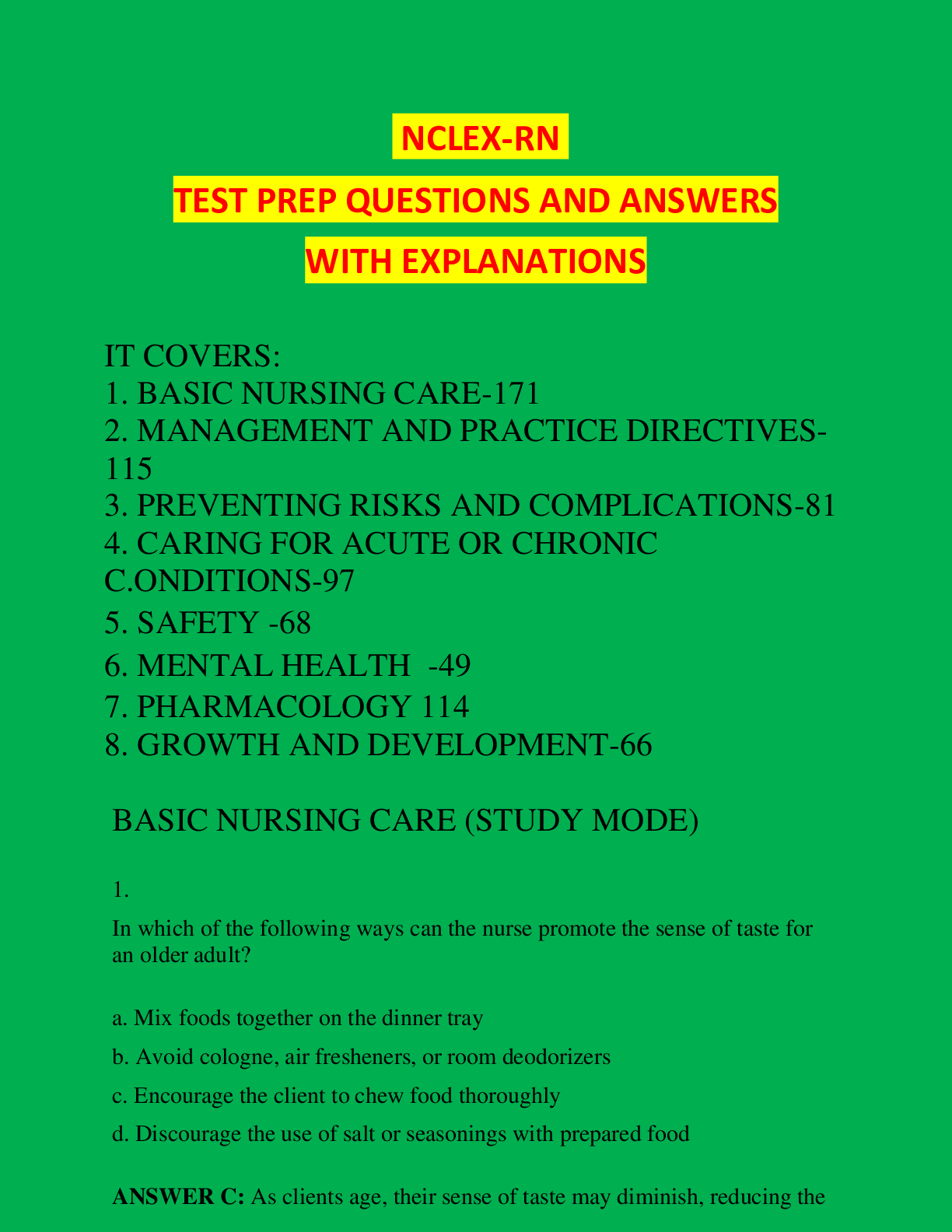*NURSING > NCLEX > Potter et al: Canadian Fundamentals of Nursing, 6th Edition/Chapter 24: Older Persons (All)
Potter et al: Canadian Fundamentals of Nursing, 6th Edition/Chapter 24: Older Persons
Document Content and Description Below
Chapter 24: Older Persons Potter et al: Canadian Fundamentals of Nursing, 6th Edition MULTIPLE CHOICE 1. As the aging population in Canada increases, which of the following is true? 2. As... a patient ages, how should the nursing plan of care change? 3. Which of these findings, if identified in a patient on a gerontological unit, would be most surprising to a culturally sensitive nurse? 4. Which of the following statements by a new graduate nurse should be corrected by an experienced nurse? 5. Which teaching strategy is best to utilize with older persons? 6. An older patient has fallen and broken his hip. As a consequence, the patient’s family is concerned about his ability to care for himself, especially during his convalescence. What should the nurse do? 7. What is the best suggestion a nurse could make to a family requesting help in selecting a local nursing centre? N R I G B.C M 8. A 70-year-old patient who suffers from worsening dementia is no longer able to live alone. In discussing health care services and possible long-term living arrangements with the patient’s only son, what should the nurse suggest? a. A nursing centre because home care is no longer safe. b. That placement is irrelevant because the patient is retreating to a place of inactivity. ANS: C Some family caregivers consider nursing centre placement when in-home care becomes increasingly difficult or when convalescence from hospitalization requires more assistance than the family is able to provide. An apartment setting and home health visits are not appropriate because older persons who cannot take care of themselves are not safe living alone at other times. Others are unable to engage in activities designed to benefit older persons such as senior health promotion activities (such as some health visits) and thus do not receive the benefits that these programs offer. Worsening dementia does not necessarily mean a retreat into inactivity, but it does require a realistic review of strengths and limitations. DIF: Apply REF: 414 OBJ: List the types of community-based and institutional health care services available to older persons. TOP: Implementation MSC: CPNRE: Foundations of Practice 9. Several theories on aging have been put forth; how should the nurse use these theories? a. To guide nursing care. b. To explain the stochastic view of genetically programmed physiological changes. c. To select one theory to guide nursing care for all geriatric patients. d. To understand the nonstochastic views of aging as the result of cellular damage. ANS: A Although theories on aging are in various stages of development and have limitations, the nurse should use them to incrNeasRe unIderGstanBdi.ngCofMthe phenomena affecting the health and well-being of older persons and to guide nursing care. According to stochastic theories, aging is the result of random cellular damage occurring over time. No single universally accepted theory predicts and explains the complexities of the aging process. According to nonstochastic theories, aging is the result of genetically programmed physiological mechanisms within the body. DIF: Apply REF: 413 OBJ: Describe the concepts of aging well and quality of life. TOP: Implementation MSC: CPNRE: Foundations of Practice 10. How would the nurse correctly describe psychosocial theories on aging? a. As theories that describe changes in roles and relationships of older persons. b. As theories that emphasize that all adults age in similar ways. c. As theories that stress the need for older people to discontinue activities as they age. d. As theories that describe behaviour patterns for all aging persons as unpredictable. ANS: A Psychosocial theories of aging explain changes in behaviours, roles, and relationships that come with aging. Although some theories generalize about aging, each individual ages uniquely both biologically and psychosocially. According to the activity theory, the continuation of activities performed during middle age is necessary for successful aging. According to the continuity theory, personality remains the same and behaviour becomes more predictable as people age. DIF: Remember REF: 419 OBJ: Discuss issues related to psychosocial changes connected with aging. TOP: Assessment MSC: CPNRE: Foundations of Practice 11. When comparing developmental tasks of middle-aged persons versus older persons, what should the nurse infer? a. Learning to cope with loss is most common during the middle adult years. b. After age 65, most older persons age both biologically and psychologically the same way. c. Older persons will need nursing assistance to deal with loss. d. Older persons fear and resent retirement as a disruption of their lifestyle. ANS: C Some older persons deny their own aging in ways that are potentially problematic. For example, some older persons deny functional declines and refuse to ask for assistance with tasks that place their safety at great risk. The need to cope with loss is much greater in the older population. The majority of older persons cope with the death of a spouse. Some must cope with the death of adult children and grandchildren. All experience the death of friends. The ways that older persons adjust to the changes of aging are highly individualized. Many older persons welcome retirement as a time to pursue new interests and hobbies, participate in volunteer activities, continue thUeirSeduNcatiTon, or sOtart a new business career. DIF: Understand REF: 415 | 419 OBJ: Discuss common developmental tasks of older persons. TOP: Assessment MSC: CPNRE: Foundations of Practice 12. An 80-year-old man is brought to the emergency department with an exacerbation of chronic obstructive pulmonary disease (COPD). He states that he quit smoking 30 years ago, so it cannot be COPD. He argues, “It’s just these colds I’ve been getting. They’re just getting worse and worse.” The nurse understands which of the following? a. These symptoms are more associated with normal aging than with disease. b. Older persons should be encouraged to maintain physical exercise and activity. c. The patient’s age will require adjustment of lifestyle to one of inactivity. d. Older persons usually are aware and accepting of the aging process. ANS: B Older persons should be encouraged to maintain physical exercise and activity, as tolerated. The primary benefits of exercise include maintaining and strengthening functional ability and promoting a sense of enhanced well-being. The COPD exacerbation is associated with the disease, not normal aging. The presence of disease sometimes alters the timing of the changes or their effect on daily life. Acceptance of personal aging does not mean retreat into inactivity, but it does require a realistic review of strengths and limitations. Some older persons find it difficult to accept that they are aging. DIF: Apply REF: 424 OBJ: Describe common physiological changes associated with aging. TOP: Planning MSC: CPNRE: Foundations of Practice 13. During assessment of an older person’s skin integrity, expected findings include which of the following? a. Decreased elasticity. b. Oily skin. c. Increased facial hair in men. d. Faster nail growth. ANS: A Loss of skin elasticity is a common finding in the older person. Other common findings include pigmentation changes, glandular atrophy (oil, moisture, sweat glands), thinning hair (facial hair: decreased in men, increased in women), slower nail growth, and atrophy of epidermal arterioles. DIF: Remember REF: 416, Table 24-1 OBJ: Describe common physiological changes associated with aging. TOP: Assessment MSC: CPNRE: Foundations of Practice 14. An older patient in no acute distress reports being less able to taste and smell. What is the nurse’s best response to this information? a. Notify the physician immediately to rule out cranial nerve damage. b. Perform testing on the vestibulocochlear nerve and a hearing test. c. Schedule the patient for an appointment at a smell and taste disorders clinic. d. Explain to the patient that diminished senses are normal in older persons. ANS: D NURSINGTB.COM Diminished taste and smell senses are common findings in older persons. Scheduling an appointment at a smell and taste disorders clinic, testing the vestibulocochlear nerve, or an attempt to rule out cranial nerve damage is unnecessary at this time per the information provided. DIF: Apply REF: 416, Table 24-1 OBJ: Describe common physiological changes associated with aging. TOP: Assessment MSC: CPNRE: Foundations of Practice 15. Which symptom is an expected cognitive change in the older person? a. Disorientation. b. Slower reaction time. c. Poor judgement. d. Loss of language skills. ANS: B Slower reaction time is a common change in older persons as a result of degeneration of nerve cells, decreased numbers of neurotransmitters, and decreased rate of conduction of impulses. Symptoms of cognitive impairment, such as disorientation, loss of language skills, loss of the ability to calculate, and poor judgement are not normal aging changes and necessitate further investigation of underlying causes. DIF: Understand REF: 416, Table 24-1 OBJ: Describe common physiological changes associated with aging. TOP: Assessment MSC: CPNRE: Foundations of Practice 16. A patient with gradual, progressive cognitive impairment (dementia) is admitted to the nursing unit after hip replacement surgery. Which of the following is a nursing care principle for care of cognitively impaired older persons? a. Maintain physical health. b. Evaluate the patient’s manifestations of standard symptoms. c. Assist the patient with all ADLs. d. Isolate the patient to protect others. ANS: A The nurse works to monitor and maintain physical health. The nurse should also assess the person’s unique manifestations of the disease as it progresses while facilitating independent performance of ADLs. Social interaction based on the patient’s abilities is to be promoted. DIF: Apply REF: 418 | 419 OBJ: Identify nursing interventions related to the physiological, cognitive, and psychosocial changes of aging. TOP: Planning MSC: CPNRE: Foundations of Practice 17. To promote physical well-being and socialization in an older person, what should the nurse realize? a. Social isolationism is always a chosen behaviour. b. Body image plays no role in decision making by the older person. c. No community resources are focused on the older person. d. Older persons may have a functional purpose in social arenas. ANS: D NURSINGTB.COM Social service agencies in most communities welcome older persons as volunteers and provide the opportunity for older persons to serve while meeting their socialization or other needs. Although some older persons choose isolation or a lifelong pattern of reduced interaction with others, other older persons do not choose isolation but are vulnerable to its consequences. Some older persons withdraw from social interaction because of feelings of rejection. These older persons see themselves as unattractive and rejected because of changes in their personal appearance resulting from normal aging or because of body image changes. Many communities have outreach programs designed to make contact with isolated older persons. DIF: Understand REF: 420 OBJ: Identify nursing interventions related to the physiological, cognitive, and psychosocial changes of aging. TOP: Implementation MSC: CPNRE: Foundations of Practice 18. A male older patient expresses his concern and anxiety about decreased penile firmness during erection. What is the nurse’s best response? a. Explaining that over time, his libido will decrease, as will the frequency of sexual activity. b. Telling the patient to double his antidepressant medication to increase his libido. c. Telling the patient that this change is expected in aging persons. d. Telling the patient that touching should be avoided unless intercourse is planned. ANS: C Decreased firmness during erection is an expected change in aging persons. Libido does not necessarily decrease as one ages. Many older persons use prescription medications that depress sexual activity, such as antihypertensives, antidepressants, sedatives, and hypnotics. Touch complements traditional sexual methods or serves as an alternative sexual expression when physical intercourse is not desired or possible. DIF: Apply REF: 420 OBJ: Identify nursing interventions related to the physiological, cognitive, and psychosocial changes of aging. TOP: Implementation MSC: CPNRE: Foundations of Practice 19. A patient asks the nurse what the term polypharmacy means. The nurse defines this term as which of the following? a. Multiple side effects experienced when a medication is taken. b. The concurrent use of many medications. c. The many adverse drug effects reported to the pharmacy. d. The risks of medication effects that are due to aging. ANS: B Polypharmacy refers to the concurrent use of many medications. It does not have anything to do with side effects, adverse drug effects, or risks of medication use that are due to aging. DIF: Remember REF: 426 OBJ: Describe selected health concerns of older persons. TOP: Implementation MSC: CPNRE: Foundations of Practice 20. An outcome for an older patient living alone is to be free from falls. Which of these statements by a patient indicates that teaching on safety concerns has been effective? a. “I’ll leave my throw rugsNinUpRlaScIe NsoGthTaBt m.yCfOeeMt won’t touch the cold tile.” b. “I’ll take my time getting up from the bed or chair.” c. “I should wear my favourite smooth bottom socks to protect my feet when walking around.” d. “I will have my son dim the lighting outside to decrease the glare in my eyes.” ANS: B Older persons taking medications with adverse effects such as postural hypotension, dizziness, or sedation need to be aware of these potential effects and to take precautions such as changing position slowly or ambulating with assistance if unsteady. Household items that are easy to trip over, such as throw rugs, are a risk factor for falls. Other risk factors include wearing shoes in poor repair or slippery soles. Impaired vision and poor lighting are other risk factors. DIF: Evaluate REF: 425 OBJ: Describe selected health concerns of older persons. TOP: Implementation MSC: CPNRE: Foundations of Practice 21. One of the greatest challenges for the nurse caring for older persons is ensuring safe medication use. What is one way to reduce the risks associated with medication usage? a. Periodically reviewing the patient’s list of medications. b. Informing the patient that polypharmacy is to be avoided at all cost. c. Being aware that medication is absorbed the same way regardless of patient age. d. Focusing only on prescribed medications. ANS: A Periodic and thorough review of all medications is important: the number of medications used should be the fewest necessary to ensure the greatest therapeutic benefit with the least amount of harm. Although polypharmacy reflects inappropriate prescribing, the concurrent use of multiple medications is necessary in situations in which an older person has multiple acute and chronic conditions. Older persons are at risk for adverse drug effects because of age-related changes in the absorption, distribution, metabolism, and excretion of drugs. Nurses should work collaboratively with older persons to ensure safe and appropriate use of all medications, both prescribed medications and over-the-counter medications. DIF: Apply REF: 426 OBJ: Describe selected health concerns of older persons. TOP: Assessment MSC: CPNRE: Foundations of Practice 22. An older patient has developed acute confusion. The patient has been taking tranquilizers for the past week. The patient’s vital signs are normal. What should the nurse do? a. Take into account age-related changes in body systems that affect pharmacokinetic activity. b. Increase the dose of tranquilizer if the cause of the confusion is an infection. c. Note when the confusion occurs and medicate before that time. d. Restrict telephone usage to prevent further confusion. ANS: A Sedatives and tranquilizers sometimes prescribed for acutely confused older persons sometimes cause or exacerbate confusion. Drugs used to manage confused behaviours should be administered carefully and must account for age-related changes in body systems that affect pharmacokinetic activity. When confusion has a physiological cause (such as an infection), the nurse should specifically treat that cause, rather than the confused behaviour. When confusion varies by time of day or is related to environmental factors, nonpharmacological measures,UsucSh asNmaTking thOe environment more meaningful and providing adequate light, should be used. Making telephone calls to friends or family members allows older persons to hear reassuring voices, which may be beneficial. DIF: Apply REF: 426 OBJ: Describe selected health concerns of older persons. TOP: Implementation MSC: CPNRE: Foundations of Practice 23. Which of these assessments of an older adult, who has a urinary tract infection, necessitates an immediate nursing intervention? a. Presbycusis. b. Confusion. c. Death of a spouse 3 months ago. d. Temperature of 36.4°C (97.6°F). ANS: B Confusion is a common manifestation in older persons with urinary tract infection; however, the cause requires further assessment. There may be another reason for the confusion. Confusion is not a normal finding in older persons, even though it is common with concurrent infections. Difficulty hearing (presbycusis) is an expected finding in older persons. Coping with the death of a spouse is a psychosocial concern to be addressed after the acute physiological concern in this case. Older persons tend to have lower temperatures, so the nurse needs to assess for slight elevations. A temperature of 36.4°C (97.6°F) is within normal limits. DIF: Apply REF: 415 OBJ: Identify nursing interventions related to the physiological, cognitive, and psychosocial changes of aging. TOP: Planning MSC: CPNRE: Foundations of Practice 24. Which of these patient statements is the most reliable indicator that an older person has the correct understanding of health promotion activities? a. “I need to increase my fat intake and limit protein.” b. “I should discontinue my fitness club membership for safety reasons.” c. “I’m up to date on my immunizations, but at my age, I don’t need the tetanus vaccine.” d. “I still keep my dentist appointments even though I have partials now.” ANS: D General preventive measures for the nurse to recommend to older persons include keeping periodic dental appointments to promote good oral hygiene; eating a low-fat, well-balanced diet; exercising regularly; and maintaining immunizations for influenza, pneumococcal pneumonia, and tetanus. DIF: Evaluate REF: 422, Box 24-8 OBJ: Describe selected health concerns of older persons. TOP: Evaluate MSC: CPNRE: Foundations of Practice 25. A 72-year-old woman was recently widowed. She worked as a teller at a bank for 40 years and has been retired for the past 5 years. She never learned how to drive. She lives in a rural area that does not have public transportation. Which of the following psychosocial changes does the nurse focus on as a priority? a. Sexuality. b. Housing and environmenNt.URSINGTB.COM c. Retirement. d. Social isolation. ANS: D The highest priority at this time is the potential for social isolation. This woman does not know how to drive and lives in a rural community that does not have public transportation. All of these factors contribute to her social isolation. Other possible changes she may be going through right now include sexuality related to her advanced age and recent death of her spouse; however, this is not the priority at this time. She has been retired for 5 years, so this is also not an immediate concern. She may eventually experience needs related to housing and environment, but the question does not indicate this as an issue at this time. DIF: Analyze REF: 419 | 420 OBJ: Describe the concepts of aging well and quality of life. TOP: Assessment MSC: CPNRE: Foundations of Practice 26. A recently widowed 80-year-old man is dehydrated and is admitted to the hospital for intravenous fluid replacement. During the evening shift, the patient becomes acutely confused, and the student nurse plans to assess the patient for a reversible cause. The nursing instructor will need to provide further instruction to the student who plans to assess for which of the following? a. Electrolyte imbalance. b. Hypoglycemia. c. Drug effects. d. Dementia. ANS: D Delirium, or acute confusional state, is a potentially reversible cognitive impairment that is often due to a physiological event. Physiological causes of delirium can include electrolyte imbalances, cerebral anoxia, hypoglycemia, medications, drug effects, tumours, subdural hematomas, and cerebrovascular infection, infarction, or hemorrhage. Unlike delirium, dementia is a gradual, progressive, irreversible cerebral dysfunction. DIF: Apply REF: 418 OBJ: Differentiate among delirium, dementia, and depression. TOP: Implementation MSC: CPNRE: Foundations of Practice NURSINGTB.COM [Show More]
Last updated: 1 year ago
Preview 1 out of 11 pages

Reviews( 0 )
Document information
Connected school, study & course
About the document
Uploaded On
Aug 08, 2021
Number of pages
11
Written in
Additional information
This document has been written for:
Uploaded
Aug 08, 2021
Downloads
0
Views
48


